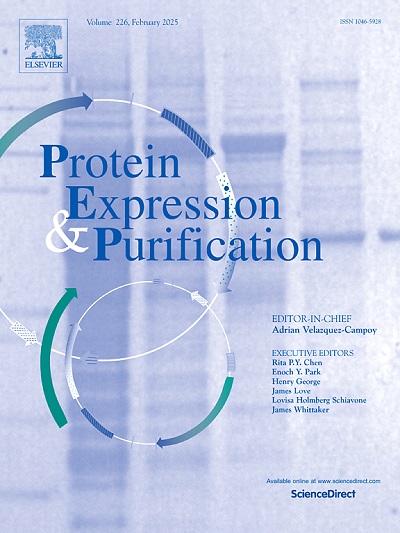分子伴侣:从细菌和酵母系统中增加溶解度的重组单克隆抗体的革命性方法
IF 1.2
4区 生物学
Q4 BIOCHEMICAL RESEARCH METHODS
引用次数: 0
摘要
重组蛋白表达彻底改变了生物技术,使生产具有高特异性和功能性的治疗蛋白、酶和抗体成为可能。大肠杆菌由于其快速生长、良好的遗传特征和成本效益,可以成为重组蛋白生产的重要宿主。然而,不溶性蛋白质聚集体的形成、错误折叠和稳定性问题是重大挑战。本文综述了分子伴侣如GroEL/GroES, DnaK/DnaJ/GrpE和Skp在重组系统中的整合,以增强重组单克隆抗体(mab)的折叠性,溶解度和活性。它还研究了共表达策略、分泌途径和工程宿主菌株在克服这些瓶颈中的作用方面的进展。此外,本文还重点介绍了在酵母中其他表达系统(包括酿酒酵母和毕氏酵母)中的比较方法,重点研究了使用Hsp70-90(分别是DnaJ和K的类似物)、无尾复合体多肽1环复合体(TRiC)和核糖体相关复合体(RAC)/新生儿多肽相关复合体(NAC)系统进行全长和片段化单克隆抗体的分子伴侣辅助折叠。聚合物纳米颗粒作为人工伴侣的应用和mRNA工程用于共翻译折叠等创新强调了优化重组蛋白生产的潜力。总的来说,这些发现提供了对伴侣蛋白和工程策略在提高单克隆抗体质量中的作用的全面把握,对生物制药制造和工业应用具有重要意义。本文章由计算机程序翻译,如有差异,请以英文原文为准。

Molecular chaperones: A revolutionary approach for increased solubility of recombinant mAbs from bacterial and yeast systems
Recombinant protein expression has revolutionized biotechnology, enabling the production of therapeutic proteins, enzymes, and antibodies with high specificity and functionality. Escherichia coli can be a prominent host for recombinant protein production due to its rapid growth, well-characterized genetics, and cost-effectiveness. However, the formation of insoluble protein aggregates, misfolding, and stability issues are significant challenges. This review explores the integration of molecular chaperones such as GroEL/GroES, DnaK/DnaJ/GrpE, and Skp in recombinant systems to enhance folding, solubility, and activity of recombinant monoclonal antibodies (mAbs). It also examines advances in co-expression strategies, secretion pathways, and the role of engineered host strains in overcoming these bottlenecks. Further, the review highlights comparative approaches in other expression systems in yeast, including Saccharomyces cerevisiae and Pichia pastoris, focusing on the molecular chaperone-assisted folding of full-length and fragmented mAbs using Hsp70-90 (analogs of DnaJ and K, respectively), tailless complex polypeptide 1 ring complex (TRiC), and ribosome-associated complex (RAC)/nascent polypeptide-associated complex (NAC) system. Innovations such as the application of polymer nanoparticles as artificial chaperones and mRNA engineering for co-translational folding underscore the potential for optimizing recombinant protein production. Collectively, these findings offer a thorough grasp of the role of chaperones and engineering strategies in improving mAbs quality, with implications for biopharmaceutical manufacturing and industrial applications.
求助全文
通过发布文献求助,成功后即可免费获取论文全文。
去求助
来源期刊

Protein expression and purification
生物-生化研究方法
CiteScore
3.70
自引率
6.20%
发文量
120
审稿时长
32 days
期刊介绍:
Protein Expression and Purification is an international journal providing a forum for the dissemination of new information on protein expression, extraction, purification, characterization, and/or applications using conventional biochemical and/or modern molecular biological approaches and methods, which are of broad interest to the field. The journal does not typically publish repetitive examples of protein expression and purification involving standard, well-established, methods. However, exceptions might include studies on important and/or difficult to express and/or purify proteins and/or studies that include extensive protein characterization, which provide new, previously unpublished information.
 求助内容:
求助内容: 应助结果提醒方式:
应助结果提醒方式:


